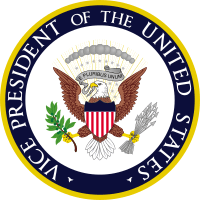List of Vice Presidents of the United States
| This article is part of a series on the |
| Politics of the United States of America |
|---|
 |
|
|
|
|
There have been 48 Vice Presidents of the United States since the office came into existence in 1789. Originally, the Vice President was the person who received the second most votes for President of the United States in the Electoral College. However, in the election of 1800, a tie in the electoral college between Thomas Jefferson and Aaron Burr led to the selection of the President by the House of Representatives. To prevent such an event from happening again, the Twelfth Amendment was added to the Constitution, creating the current system where electors cast a separate ballot for the vice presidency.[1]
The Vice President is the first person in the presidential line of succession, and assumes that office if the President dies, resigns, or is impeached and removed from office.[2] Nine vice presidents have ascended to the presidency in this way: eight (John Tyler, Millard Fillmore, Andrew Johnson, Chester A. Arthur, Theodore Roosevelt, Calvin Coolidge, Harry S. Truman and Lyndon B. Johnson) through the president's death, and one (Gerald Ford) through the president's resignation. In addition, the Vice President serves as the President of the Senate and may choose to cast a tie-breaking vote on decisions made by the Senate. U.S. Vice Presidents have exercised this latter power to varying extents over the years.[1]
Prior to adoption of the Twenty-fifth Amendment in 1967, an intra-term vacancy in the office of the Vice President could not be filled until the next post-election inauguration. Several such vacancies occurred—seven vice presidents died, one resigned, and eight succeeded to the presidency. This amendment allowed for a vacancy to be filled through appointment by the President and confirmation by both chambers of the U.S. Congress. Since its ratification, the vice presidency has been vacant twice (both in the context of scandals surrounding the Nixon Administration), and was filled both times through this process: in 1973, following Spiro Agnew's resignation, and again in 1974, after Gerald Ford succeeded to the presidency.[1] The amendment also established a procedure whereby a Vice President may, if the president is unable to discharge the powers and duties of the office, temporarily assume the powers and duties of the office as Acting President. George H. W. Bush did so once, on July 13, 1985. Dick Cheney did so twice, on June 29, 2002, and on July 21, 2007.
The persons who have served as vice president were born in or primarily affiliated with 27 states plus the District of Columbia. New York has produced the most of any state, as eight have been born there, and three others considered it their home state. Most U.S. Vice Presidents have been in their 50s or 60s and had political experience prior to assuming the office.[1] The youngest person to become Vice President was John C. Breckinridge at 36 years of age, while the oldest was Alben W. Barkley at 71 years of age. Two U.S. Vice Presidents—George Clinton and John C. Calhoun—served under more than one President.
List
| Pro-Administration (1) Federalist (1) Democratic-Republican (6) Nullifier (1) Democratic (17) Whig (2) Republican (21) National Union (1) | ||||||||
|---|---|---|---|---|---|---|---|---|
| Vice presidency | Vice President[lower-alpha 1] | Prior office[lower-alpha 2] | Party | Election | President | |||
| 1 | April 21, 1789[lower-alpha 3] – March 4, 1797 |
.jpg) |
John Adams 1735–1826 (Lived: 90 years) [3][4][5] |
United States Minister to the Court of St. James's (1785–1788) |
Pro- Admin.[lower-alpha 4] |
1 (1788–89) |
George Washington[lower-alpha 5] | |
| Federalist | 2 (1792) | |||||||
| 2 | March 4, 1797 – March 4, 1801 |
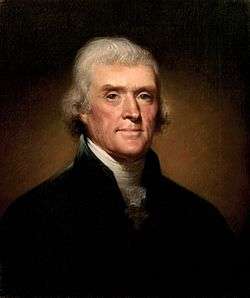 |
Thomas Jefferson 1743–1826 (Lived: 83 years) [6][7][8] |
1st United States Secretary of State (1790–1793) |
Democratic- Republican |
3 (1796) |
John Adams[lower-alpha 6] | |
| 3 | March 4, 1801 – March 4, 1805 |
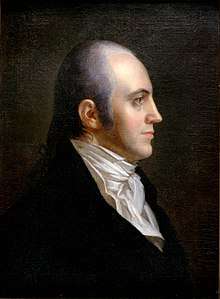 |
Aaron Burr 1756–1836 (Lived: 80 years) [9] |
Member of the New York State Assembly (1784–1785 & 1798–1799) |
Democratic- Republican |
4 (1800) |
Thomas Jefferson | |
| 4 | March 4, 1805 – April 20, 1812 (Died in office) |
 |
George Clinton 1739–1812 (Lived: 72 years) [10] |
1st Governor of New York (1777–1795 & 1801–1804) |
Democratic- Republican |
5 (1804) | ||
| 6 (1808) |
James Madison | |||||||
| Office vacant April 20, 1812 – March 4, 1813[lower-alpha 7] | ||||||||
| 5 | March 4, 1813 – November 23, 1814 (Died in office) |
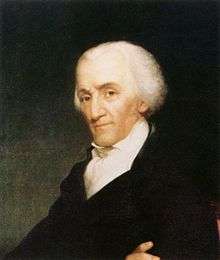 |
Elbridge Gerry 1744–1814 (Lived: 70 years) [11] |
9th Governor of Massachusetts (1810–1812) |
Democratic- Republican |
7 (1812) | ||
| Office vacant November 23, 1814 – March 4, 1817[lower-alpha 7] | ||||||||
| 6 | March 4, 1817 – March 4, 1825 |
 |
Daniel D. Tompkins 1774–1825 (Lived: 50 years) [12] |
4th Governor of New York (1807–1817) |
Democratic- Republican |
8 (1816) |
James Monroe | |
| 9 (1820) | ||||||||
| 7 | March 4, 1825 – December 28, 1832 (Resigned from office) |
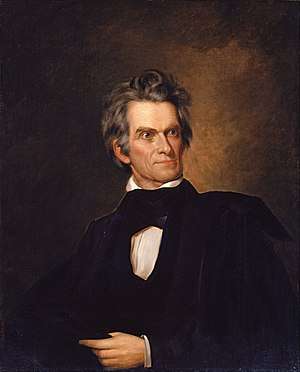 |
John C. Calhoun 1782–1850 (Lived: 68 years) [13] |
10th United States Secretary of War (1817–1825) |
Democratic- Republican |
10 (1824) |
John Q. Adams | |
| Nullifier[lower-alpha 8] Democratic |
11 (1828) |
Andrew Jackson[lower-alpha 9] | ||||||
| Office vacant December 28, 1832 – March 4, 1833[lower-alpha 7] | ||||||||
| 8 | March 4, 1833 – March 4, 1837 |
 |
Martin Van Buren 1782–1862 (Lived: 79 years) [14][15][16] |
United States Minister to the Court of St. James's (1831–1832) |
Democratic | 12 (1832) | ||
| 9 | March 4, 1837 – March 4, 1841 |
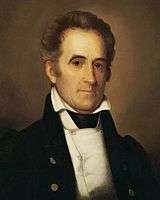 |
Richard M. Johnson 1780–1850 (Lived: 70 years) [17] |
U.S. Representative for Kentucky's 13th district (1833–1837) |
Democratic | 13 (1836) |
Martin Van Buren | |
| 10 | March 4, 1841 – April 4, 1841 (Became President) |
 |
John Tyler 1790–1862 (Lived: 71 years) [18][19][20] |
U.S. Senator from Virginia (1827–1836) |
Whig | 14 (1840) |
William H. Harrison (Died in office) | |
| Office vacant April 4, 1841 – March 4, 1845[lower-alpha 7] | John Tyler | |||||||
| 11 | March 4, 1845 – March 4, 1849 |
 |
George M. Dallas 1792–1864 (Lived: 72 years) [21] |
United States Minister to Russia (1837–1839) |
Democratic | 15 (1844) |
James K. Polk | |
| 12 | March 4, 1849 – July 9, 1850 (Became President) |
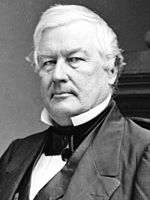 |
Millard Fillmore 1800–1874 (Lived: 74 years) [22][23][24] |
14th New York State Comptroller (1848–1849) |
Whig | 16 (1848) |
Zachary Taylor (Died in office) | |
| Office vacant July 9, 1850 – March 4, 1853[lower-alpha 7] | Millard Fillmore | |||||||
| 13 | March 4, 1853[lower-alpha 10] – April 18, 1853 (Died in office) |
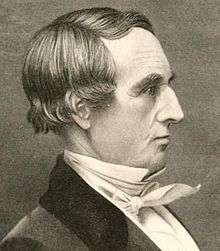 |
William R. King 1786–1853 (Lived: 67 years) [25] |
U.S. Senator from Alabama (1819–1844 & 1848–1852) President pro tempore (1850–1852) |
Democratic | 17 (1852) |
Franklin Pierce | |
| Office vacant April 18, 1853 – March 4, 1857[lower-alpha 7] | ||||||||
| 14 | March 4, 1857 – March 4, 1861 |
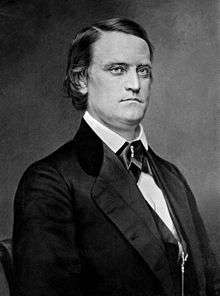 |
John C. Breckinridge 1821–1875 (Lived: 54 years) [26] |
U.S. Representative for Kentucky's 8th district (1851–1855) |
Democratic | 18 (1856) |
James Buchanan | |
| 15 | March 4, 1861 – March 4, 1865 |
 |
Hannibal Hamlin 1809–1891 (Lived: 81 years) [27] |
U.S. Senator from Maine (1848–1857 & 1857–1861) |
Republican | 19 (1860) |
Abraham Lincoln[lower-alpha 11] (Died in office) | |
| 16 | March 4, 1865 – April 15, 1865 (Became President) |
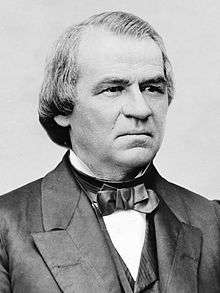 |
Andrew Johnson 1808–1875 (Lived: 66 years) [28][29][30] |
15th Governor of Tennessee (1853–1857) Military Governor of Tennessee (1862–1865) |
National Union | 20 (1864) | ||
| Office vacant April 15, 1865 – March 4, 1869[lower-alpha 7] | Andrew Johnson | |||||||
| 17 | March 4, 1869 – March 4, 1873 |
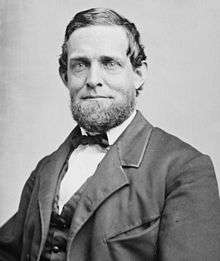 |
Schuyler Colfax 1823–1885 (Lived: 61 years) [31] |
U.S. Representative for Indiana's 9th district (1855–1869) Speaker of the House (1863–1869) |
Republican | 21 (1868) |
Ulysses S. Grant | |
| 18 | March 4, 1873 – November 22, 1875 (Died in office) |
 |
Henry Wilson 1812–1875 (Lived: 63 years) [32] |
U.S. Senator from Massachusetts (1855–1873) |
Republican | 22 (1872) | ||
| Office vacant November 22, 1875 – March 4, 1877[lower-alpha 7] | ||||||||
| 19 | March 4, 1877 – March 4, 1881 |
 |
William A. Wheeler 1819–1887 (Lived: 67 years) [33] |
U.S. Representative for New York's 19th district (1875–1877) |
Republican | 23 (1876) |
Rutherford B. Hayes | |
| 20 | March 4, 1881 – September 19, 1881 (Became President) |
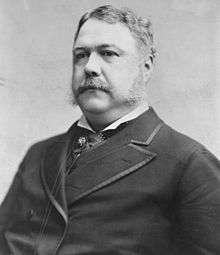 |
Chester A. Arthur 1829–1886 (Lived: 57 years) [34][35][36] |
10th Chairman of the New York State Republican Executive Committee (1879–1881) (No prior elected office) |
Republican | 24 (1880) |
James A. Garfield (Died in office) | |
| Office vacant September 19, 1881 – March 4, 1885[lower-alpha 7] | Chester A. Arthur | |||||||
| 21 | March 4, 1885 – November 25, 1885 (Died in office) |
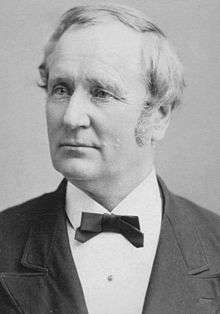 |
Thomas A. Hendricks 1819–1885 (Lived: 66 years) [37] |
16th Governor of Indiana (1873–1877) |
Democratic | 25 (1884) |
Grover Cleveland | |
| Office vacant November 25, 1885 – March 4, 1889[lower-alpha 7] | ||||||||
| 22 | March 4, 1889 – March 4, 1893 |
 |
Levi P. Morton 1824–1920 (Lived: 96 years) [38] |
U.S. Minister to France (1881–1885) |
Republican | 26 (1888) |
Benjamin Harrison | |
| 23 | March 4, 1893 – March 4, 1897 |
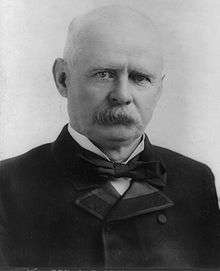 |
Adlai Stevenson 1835–1914 (Lived: 78 years) [39] |
First Assistant United States Postmaster General (1885–1889) |
Democratic | 27 (1892) |
Grover Cleveland | |
| 24 | March 4, 1897 – November 21, 1899 (Died in office) |
 |
Garret Hobart 1844–1899 (Lived: 55 years) [40] |
Vice Chairman of the Republican National Committee (1892–1896) |
Republican | 28 (1896) |
William McKinley (Died in office) | |
| Office vacant November 21, 1899 – March 4, 1901[lower-alpha 7] | ||||||||
| 25 | March 4, 1901 – September 14, 1901 (Became President) |
 |
Theodore Roosevelt 1858–1919 (Lived: 60 years) [41][42][43] |
33rd Governor of New York (1899–1900) |
Republican | 29 (1900) | ||
| Office vacant September 14, 1901 – March 4, 1905[lower-alpha 7] | Theodore Roosevelt | |||||||
| 26 | March 4, 1905 – March 4, 1909 |
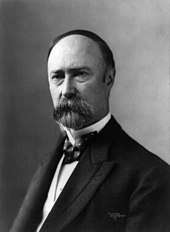 |
Charles W. Fairbanks 1852–1918 (Lived: 66 years) [44] |
U.S. Senator from Indiana (1897–1905) |
Republican | 30 (1904) | ||
| 27 | March 4, 1909 – October 30, 1912 (Died in office) |
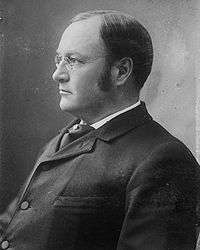 |
James S. Sherman 1855–1912 (Lived: 57 years) [45] |
U.S. Representative for New York's 27th district (1903–1909) |
Republican | 31 (1908) |
William H. Taft | |
| Office vacant October 30, 1912 – March 4, 1913[lower-alpha 7] | ||||||||
| 28 | March 4, 1913 – March 4, 1921 |
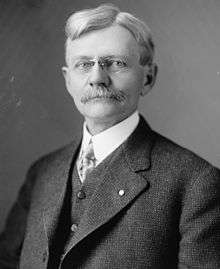 |
Thomas R. Marshall 1854–1925 (Lived: 71 years) [46] |
27th Governor of Indiana (1909–1913) |
Democratic | 32 (1912) |
Woodrow Wilson | |
| 33 (1916) | ||||||||
| 29 | March 4, 1921 – August 2, 1923 (Became President) |
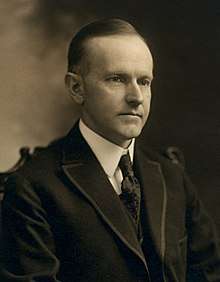 |
Calvin Coolidge 1872–1933 (Lived: 60 years) [47][48][49] |
48th Governor of Massachusetts (1919–1921) |
Republican | 34 (1920) |
Warren G. Harding (Died in office) | |
| Office vacant August 2, 1923 – March 4, 1925[lower-alpha 7] | Calvin Coolidge | |||||||
| 30 | March 4, 1925 – March 4, 1929 |
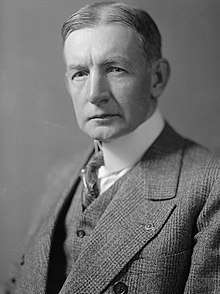 |
Charles G. Dawes 1865–1951 (Lived: 85 years) [50] |
1st Director of the U.S. Bureau of the Budget (1921–1922) (No prior elected office) |
Republican | 35 (1924) | ||
| 31 | March 4, 1929 – March 4, 1933 |
 |
Charles Curtis 1860–1936 (Lived: 76 years) [51] |
U.S. Senator from Kansas (1907–1913 & 1915–1929) President pro tempore (1911) Senate Majority Leader (1925–1929) |
Republican | 36 (1928) |
Herbert Hoover | |
| 32 | March 4, 1933 – January 20, 1941[lower-alpha 12] |
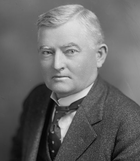 |
John N. Garner 1868–1967 (Lived: 98 years) [52] |
U.S. Representative for Texas's 15th district (1903–1933) House Minority Leader (1929–1931) Speaker of the House (1931–1933) |
Democratic | 37 (1932) |
Franklin D. Roosevelt (Died in office) | |
| 38 (1936) | ||||||||
| 33 | January 20, 1941 – January 20, 1945 |
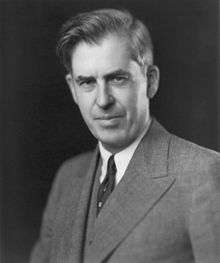 |
Henry A. Wallace 1888–1965 (Lived: 77 years) [53] |
11th United States Secretary of Agriculture (1933–1940) (No prior elected office) |
Democratic | 39 (1940) | ||
| 34 | January 20, 1945 – April 12, 1945 (Became President) |
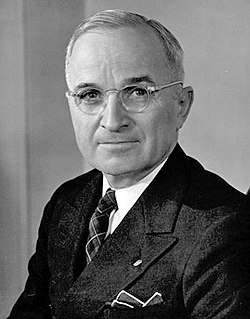 |
Harry S. Truman 1884–1972 (Lived: 88 years) [54][55][56] |
U.S. Senator from Missouri (1935–1945) |
Democratic | 40 (1944) | ||
| Office vacant April 12, 1945 – January 20, 1949[lower-alpha 7] | Harry S. Truman | |||||||
| 35 | January 20, 1949 – January 20, 1953 |
 |
Alben W. Barkley 1877–1956 (Lived: 78 years) [57] |
U.S. Senator from Kentucky (1927–1949) Senate Majority Leader (1937–1947) Senate Minority Leader (1947–1949) |
Democratic | 41 (1948) | ||
| 36 | January 20, 1953 – January 20, 1961 |
 |
Richard Nixon 1913–1994 (Lived: 81 years) [58][59][60] |
U.S. Senator from California (1950–1953) |
Republican | 42 (1952) |
Dwight D. Eisenhower | |
| 43 (1956) | ||||||||
| 37 | January 20, 1961 – November 22, 1963 (Became President) |
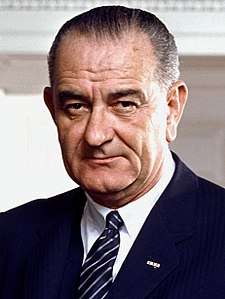 |
Lyndon B. Johnson 1908–1973 (Lived: 64 years) [61][62] |
U.S. Senator from Texas (1949–1961) Senate Majority Leader (1955–1961) |
Democratic | 44 (1960) |
John F. Kennedy (Died in office) | |
| Office vacant November 22, 1963 – January 20, 1965[lower-alpha 7] | Lyndon B. Johnson | |||||||
| 38 | January 20, 1965 – January 20, 1969 |
 |
Hubert Humphrey 1911–1978 (Lived: 66 years) [63] |
U.S. Senator from Minnesota (1949–1964) Senate Majority Whip (1961–1964) |
Democratic | 45 (1964) | ||
| 39 | January 20, 1969 – October 10, 1973 (Resigned from office) |
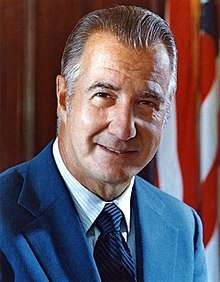 |
Spiro Agnew 1918–1996 (Lived: 77 years) [64] |
55th Governor of Maryland (1967–1969) |
Republican | 46 (1968) |
Richard Nixon (Resigned from office) | |
| 47 (1972) | ||||||||
| Office vacant October 10 – December 6, 1973[lower-alpha 13] | ||||||||
| 40 | December 6, 1973 – August 9, 1974 (Became President) |
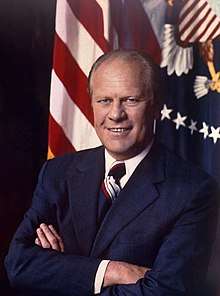 |
Gerald Ford 1913–2006 (Lived: 93 years) [65][66][67] |
U.S. Representative for Michigan's 5th district (1949–1973) House Minority Leader (1965–1973) |
Republican | |||
| Office vacant August 9 – December 19, 1974[lower-alpha 13] | Gerald Ford | |||||||
| 41 | December 19, 1974 – January 20, 1977 |
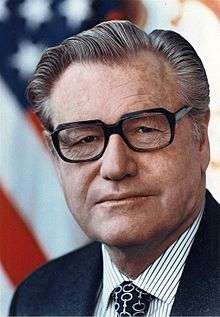 |
Nelson Rockefeller 1908–1979 (Lived: 70 years) [68] |
49th Governor of New York (1959–1973) |
Republican | |||
| 42 | January 20, 1977 – January 20, 1981 |
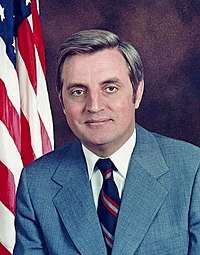 |
Walter Mondale Born 1928 (90 years old) [69] |
U.S. Senator from Minnesota (1964–1976) |
Democratic | 48 (1976) |
Jimmy Carter | |
| 43 | January 20, 1981 – January 20, 1989 |
 |
George H. W. Bush Born 1924 (94 years old) [70][71][72] |
11th Director of Central Intelligence (1976–1977) |
Republican | 49 (1980) |
Ronald Reagan | |
| 50 (1984) | ||||||||
| 44 | January 20, 1989 – January 20, 1993 |
 |
Dan Quayle Born 1947 (71 years old) [73] |
U.S. Senator from Indiana (1981–1989) |
Republican | 51 (1988) |
George H. W. Bush | |
| 45 | January 20, 1993 – January 20, 2001 |
 |
Al Gore Born 1948 (70 years old) [74] |
U.S. Senator from Tennessee (1985–1993) |
Democratic | 52 (1992) |
Bill Clinton | |
| 53 (1996) | ||||||||
| 46 | January 20, 2001 – January 20, 2009 |
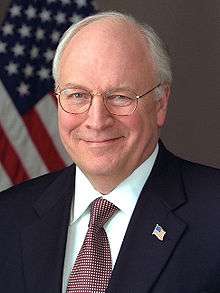 |
Dick Cheney Born 1941 (77 years old) [75] |
17th United States Secretary of Defense (1989–1993) |
Republican | 54 (2000) |
George W. Bush | |
| 55 (2004) | ||||||||
| 47 | January 20, 2009 – January 20, 2017 |
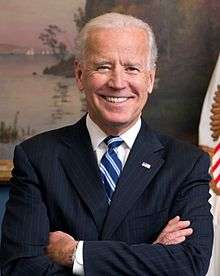 |
Joe Biden Born 1942 (75 years old) [76] |
U.S. Senator from Delaware (1973–2009) |
Democratic | 56 (2008) |
Barack Obama | |
| 57 (2012) | ||||||||
| 48 | January 20, 2017 – Incumbent |
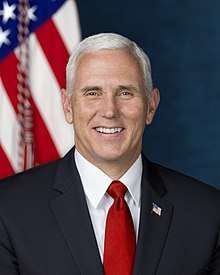 |
Mike Pence Born 1959 (59 years old) [77][78] |
50th Governor of Indiana (2013–2017) |
Republican | 58 (2016) |
Donald Trump | |
Subsequent public office
Twenty–five vice presidents held other high U.S. state or federal government positions after leaving the vice presidency. Fourteen went on to become President of the United States (nine of them following their predecessor's death or resignation), and 4 served in the United States Senate. Several served as a member of the Cabinet of the United States, Ambassador of the United States or in state government.
In addition to their post-vice presidency service to the United States, two former Vice Presidents served in the Government of the Confederate States of America during the Civil War: John Tyler, as a member of the Provisional Confederate Congress, 1861–1862, elected to the Confederate House of Representatives in November 1861, but died before he could take his seat; and John C. Breckinridge, as Confederate States Secretary of War, 1865.
Notes
- 1 2 The U.S. Vice Presidents are counted according to uninterrupted periods of time served by the same person. For example, John Adams served two consecutive terms and is counted as the first vice president (not the first and second). Likewise, George Clinton is counted as the fourth and John Calhoun as the seventh, even though each one's consecutive terms in office were served under more than one president. Following the resignation of 39th vice president Spiro Agnew, Gerald Ford became the 40th vice president even though he was chosen to serve out the remainder of Agnew's second term. Then, after Ford succeeded to the presidency later in that same term, Nelson Rockefeller became the 41st vice president and served out the remainder of the term.
- ↑ Listed here (unless otherwise noted) is the most recent position—either with a U.S. state or the federal government, or with a private corporation—held by the individual prior to becoming Vice President of the United States.
- ↑ Due to logistical delays, John Adams assumed the office of Vice President 1 month and 17 days after the March 4, 1789 scheduled start of operations of the new government under the Constitution. As a result, his first term was only 1,413 days long, and was the shortest term for a U.S. vice president who served a full term.
- ↑ Pro-Administration is a contemporary term used to describe the supporters of the political and economic policies of the Washington Administration prior to the formation of the Federalist and Democratic–Republican parties.
- ↑ George Washington remained unaffiliated with any political faction or party throughout his eight-year presidency. Greatly concerned about the very real capacity of political parties to destroy the fragile unity holding the nation together, he was, and remains, the only U.S. President never to be affiliated with a political party.
- ↑ The 1796 presidential election was the first contested American presidential election and resulted in a situation where the persons elected President and Vice President belonged to opposing political parties. Federalist John Adams was elected President, and Thomas Jefferson of the Democratic-Republicans was elected Vice President.
- 1 2 3 4 5 6 7 8 9 10 11 12 13 14 15 16 Prior to ratification of the Twenty-fifth Amendment, February 10, 1967, an intra-term vacancy in the vice presidency could not be filled.
- ↑ John Calhoun, formerly a Democratic-Republican, founded the Nullifier Party in 1828 to advance the cause of states' rights, but was brought on as Andrew Jackson's running mate in the 1828 presidential election in an effort to broaden the political coalition emerging around Jackson.
- ↑ Andrew Jackson's supporters from the former Democratic-Republican Party, which had largely collapsed by the mid-1820s, began calling themselves Democrat' during his first term in office, thus marking the evolution of Thomas Jefferson's Democratic-Republican Party into the modern Democratic Party.
- ↑ Ill with tuberculosis, William King traveled to Cuba after the 1852 election in an effort to regain his health, and was not able to be in Washington, D.C. to take his oath of office on March 4, 1853. By a Special Act of Congress, he was allowed to take the oath outside the United States, and was sworn in on March 24, 1853 near Matanzas, Cuba. He is the only Vice President to take his oath of office in a foreign country.
- ↑ When he ran for reelection in 1864, Republican Abraham Lincoln formed a bipartisan electoral alliance with War Democrats by selecting Democrat Andrew Johnson as his running mate, and running on the National Union Party ticket.
- ↑ The Twentieth Amendment to the United States Constitution, ratified on January 23, 1933, moved Inauguration Day from March 4 to January 20, beginning in 1937. As a result, John Nance Garner's first term in office was 1 month and 12 days shorter than a normal term.
- 1 2 The Twenty-fifth Amendment established a process whereby an intra-term vacancy in the vice presidency is filled by presidential appointment.
See also
References
- 1 2 3 4 "Vice President of the United States (President of the Senate)". United States Senate. Retrieved June 10, 2009.
- ↑ "Vice President". US Legal System. USLegal. Retrieved June 17, 2018.
- ↑ "Biography of John Adams". Whitehouse.gov. March 12, 2007. Retrieved January 12, 2009.
- ↑ "John Adams – Federalist Party – 2nd President – American Presidents". History. Archived from the original on February 25, 2009. Retrieved January 12, 2009.
- ↑ "Life Portrait of John Adams". American Presidents: Life Portrait. C-SPAN. Retrieved March 6, 2016.
- ↑ "Biography of Thomas Jefferson". Whitehouse.gov. March 12, 2007. Retrieved January 12, 2009.
- ↑ "Thomas Jefferson – Democratic-Republican Party – 3rd President – American Presidents". History. Archived from the original on March 5, 2009. Retrieved January 12, 2009.
- ↑ "Life Portrait of Thomas Jefferson". American Presidents: Life Portrait. C-SPAN. Retrieved March 6, 2016.
- ↑ "Aaron Burr (1801–1805) – Vice President". Miller Center of Public Affairs, University of Virginia. Retrieved September 6, 2016.
- ↑ "George Clinton (1805–1809) – Vice President". Miller Center of Public Affairs, University of Virginia. Retrieved September 6, 2016.
- ↑ "Elbridge Gerry (1813–1814) – Vice President". Miller Center of Public Affairs, University of Virginia. Archived from the original on October 21, 2016. Retrieved September 6, 2016.
- ↑ "Daniel D. Tompkins (1817–1825) – Vice President". Miller Center of Public Affairs, University of Virginia. Retrieved September 6, 2016.
- ↑ "John C. Calhoun (1825–1829) – Vice President". Miller Center of Public Affairs, University of Virginia. Retrieved September 6, 2016.
- ↑ "Biography of Martin Van Buren". Whitehouse.gov. March 12, 2007. Retrieved January 12, 2009.
- ↑ "Martin Van Buren – Democratic-Republican, Democratic, and Free Soil Party – 8th President – American Presidents". History. Archived from the original on March 5, 2009. Retrieved January 12, 2009.
- ↑ "Life Portrait of Martin Van Buren". American Presidents: Life Portrait. C-SPAN. Retrieved March 6, 2016.
- ↑ "Richard M. Johnson (1837–1841) – Vice President". Miller Center of Public Affairs, University of Virginia. Retrieved September 6, 2016.
- ↑ "Biography of John Tyler". Whitehouse.gov. March 12, 2007. Retrieved January 12, 2009.
- ↑ "John Tyler – No Party – 10th President – American Presidents". History. Archived from the original on March 5, 2009. Retrieved January 12, 2009.
- ↑ "Life Portrait of John Tyler". American Presidents: Life Portrait. C-SPAN. Retrieved March 6, 2016.
- ↑ "George M. Dallas (1845–1849) – Vice President". Miller Center of Public Affairs, University of Virginia. Retrieved September 6, 2016.
- ↑ "Biography of Millard Fillmore". Whitehouse.gov. March 12, 2007. Retrieved January 12, 2009.
- ↑ "Millard Filmore – WHIG Party – 13th President – American Presidents". History. Archived from the original on March 5, 2009. Retrieved January 12, 2009.
- ↑ "Life Portrait of Millard Fillmore". American Presidents: Life Portrait. C-SPAN. Retrieved March 6, 2016.
- ↑ "William R. D. King (1853) – Vice President". Miller Center of Public Affairs, University of Virginia. Retrieved September 6, 2016.
- ↑ "John C. Breckinridge (1857–1861) – Vice President". Miller Center of Public Affairs, University of Virginia. Retrieved September 6, 2016.
- ↑ "Hannibal Hamlin (1861–1865) – Vice President". Miller Center of Public Affairs, University of Virginia. Retrieved September 6, 2016.
- ↑ "Biography of Andrew Johnson". Whitehouse.gov. March 12, 2007. Retrieved January 12, 2009.
- ↑ "Andrew Johnson – National Union Party – 17th President – American Presidents". History. Archived from the original on March 5, 2009. Retrieved January 12, 2009.
- ↑ "Life Portrait of Andrew Johnson". American Presidents: Life Portrait. C-SPAN. Retrieved March 6, 2016.
- ↑ "Schuyler Colfax (1869–1873) – Vice President". Miller Center of Public Affairs, University of Virginia. Retrieved September 6, 2016.
- ↑ "Henry Wilson (1873–1875) – Vice President". Miller Center of Public Affairs, University of Virginia. Retrieved September 6, 2016.
- ↑ "William A. Wheeler (1877–1881) – Vice President". Miller Center of Public Affairs, University of Virginia. Retrieved September 6, 2016.
- ↑ "Biography of Chester Arthur". Whitehouse.gov. March 12, 2007. Retrieved January 12, 2009.
- ↑ "Chester A. Arthur – Republican Party – 21st President – American Presidents". History. Archived from the original on March 5, 2009. Retrieved January 12, 2009.
- ↑ "Life Portrait of Chester A. Arthur". American Presidents: Life Portrait. C-SPAN. Retrieved March 6, 2016.
- ↑ "Thomas A. Hendricks (1885) – Vice President". Miller Center of Public Affairs, University of Virginia. Retrieved September 6, 2016.
- ↑ "Levi P. Morton – Vice President". Miller Center of Public Affairs, University of Virginia. Retrieved September 6, 2016.
- ↑ "Adlai E. Stevenson (1893–1897) – Vice President". Miller Center of Public Affairs, University of Virginia. Retrieved September 6, 2016.
- ↑ "Garret A. Hobart (1897–1899) – Vice President". Miller Center of Public Affairs, University of Virginia. Retrieved September 6, 2016.
- ↑ "Biography of Theodore Roosevelt". Whitehouse.gov. March 12, 2007. Retrieved January 12, 2009.
- ↑ "Theodore Roosevelt – Republican, Bull Moose Party – 26th President – American Presidents". History. Archived from the original on February 26, 2009. Retrieved January 12, 2009.
- ↑ "Life Portrait of Theodore Roosevelt". American Presidents: Life Portrait. C-SPAN. Retrieved March 6, 2016.
- ↑ "Charles W. Fairbanks – Vice President". Miller Center of Public Affairs, University of Virginia. Retrieved September 6, 2016.
- ↑ "James S. Sherman – Vice President". Miller Center of Public Affairs, University of Virginia. Retrieved September 6, 2016.
- ↑ "Thomas R. Marshall – Vice President". Miller Center of Public Affairs, University of Virginia. Retrieved September 6, 2016.
- ↑ "Biography of Calvin Coolidge". Whitehouse.gov. March 13, 2007. Retrieved January 12, 2009.
- ↑ "Calvin Coolidge – Republican Party – 30th President – American Presidents". History. Archived from the original on March 5, 2009. Retrieved January 12, 2009.
- ↑ "Life Portrait of Calvin Coolidge". American Presidents: Life Portrait. C-SPAN. Retrieved March 6, 2016.
- ↑ "Charles G. Dawes – Vice President". Miller Center of Public Affairs, University of Virginia. Retrieved September 6, 2016.
- ↑ "Charles Curtis – Vice President". Miller Center of Public Affairs, University of Virginia. Retrieved September 6, 2016.
- ↑ "John N. Garner (1933–1941) – Vice President". Miller Center of Public Affairs, University of Virginia. Retrieved September 6, 2016.
- ↑ "Henry A. Wallace (1941–1945) – Vice President". Miller Center of Public Affairs, University of Virginia. Retrieved September 6, 2016.
- ↑ "Biography of Harry S Truman". Whitehouse.gov. March 12, 2007. Retrieved January 12, 2009.
- ↑ "Harry S Truman – Democratic Party – 33rd President – American Presidents". History. Archived from the original on February 25, 2009. Retrieved January 12, 2009.
- ↑ "Life Portrait of Harry S. Truman". American Presidents: Life Portrait. C-SPAN. Retrieved March 7, 2016.
- ↑ "Alben W. Barkley – Vice President". Miller Center of Public Affairs, University of Virginia. Retrieved September 6, 2016.
- ↑ "Richard M. Nixon". Whitehouse.gov. March 12, 2007. Retrieved January 12, 2009.
- ↑ "Richard Nixon – Republican Party – 37th President – American Presidents". History. Archived from the original on February 25, 2009. Retrieved January 12, 2009.
- ↑ "Life Portrait of Richard M. Nixon". American Presidents: Life Portrait. C-SPAN. Retrieved March 7, 2016.
- ↑ "Lyndon B. Johnson – Democratic Party – 36th President – American Presidents". History. Archived from the original on February 26, 2009. Retrieved January 12, 2009.
- ↑ "Life Portrait of Lyndon B. Johnson". American Presidents: Life Portrait. C-SPAN. Retrieved March 7, 2016.
- ↑ "Hubert H. Humphrey – Vice President". Miller Center of Public Affairs, University of Virginia. Retrieved September 6, 2016.
- ↑ "Spiro T. Agnew (1969–1973) – Vice President". Miller Center of Public Affairs, University of Virginia. Retrieved September 6, 2016.
- ↑ "Biography of Gerald R. Ford". Whitehouse.gov. March 12, 2007. Retrieved January 12, 2009.
- ↑ "Gerald Ford – Republican Party – 38th President – American Presidents". History. Archived from the original on March 5, 2009. Retrieved January 12, 2009.
- ↑ "Life Portrait of Gerald R. Ford". American Presidents: Life Portrait. C-SPAN. Retrieved March 7, 2016.
- ↑ "Nelson A. Rockefeller – Vice President". Miller Center of Public Affairs, University of Virginia. Retrieved September 6, 2016.
- ↑ "Walter Mondale – Vice President". Miller Center of Public Affairs, University of Virginia. Retrieved September 6, 2016.
- ↑ "Biography of George Herbert Walker Bush". Whitehouse.gov. March 12, 2007. Retrieved January 12, 2009.
- ↑ "George H. W. Bush – Republican Party – 41st President – American Presidents". History. Retrieved January 12, 2009.
- ↑ "Life Portrait of George H.W. Bush". American Presidents: Life Portrait. C-SPAN. Retrieved March 7, 2016.
- ↑ "J. Danforth Quayle – Vice President". Miller Center of Public Affairs, University of Virginia. Retrieved September 6, 2016.
- ↑ "Albert Gore, Jr. – Vice President". Miller Center of Public Affairs, University of Virginia. Retrieved September 6, 2016.
- ↑ "Richard B. Cheney – Vice President". Miller Center of Public Affairs, University of Virginia. Retrieved September 6, 2016.
- ↑ "Joseph Biden – Vice President". Miller Center of Public Affairs, University of Virginia. Retrieved September 6, 2016.
- ↑ Flegenheimer, Matt; Barbaro, Michael (November 9, 2016). "Donald Trump Is Elected President in Stunning Repudiation of the Establishment". The New York Times. Retrieved November 13, 2016.
- ↑ "Vice President Mike Pence". whitehouse.gov. January 20, 2017. Retrieved January 31, 2017.
External links
| Wikimedia Commons has media related to Vice Presidents of the United States. |
- Official White House website for the Vice President
- Vice presidents of the United States, July 22, 2016, CNN.com
- Vice Presidents of the United States 1789–1993 Mark O. Hatfield, et al.; edited by Wendy Wolff, U.S. Senate Historical Office. U.S. Government Printing Office; Washington, 1997.
